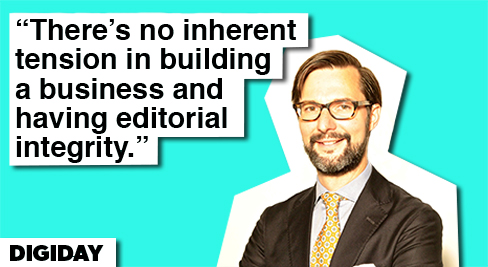
Travel + Leisure has named a new editor, Nathan Lump. He’s an unusual candidate for the role; after following a traditional editorial path at T: The New York Times Style Magazine and Travel + Leisure, he segued to the business side several years ago, leading content strategy at J. Walter Thompson and Hill Holliday and becoming director of branded content at Condé Nast in 2012.
He returns to T+L, which was since bought by Time Inc., as the No. 1 U.S. consumer magazine publisher is dismantling the traditional lines that separated editorial and business, an industry trend that some see as discomforting but others call necessary to publishers’ survival. Lump, who starts his new gig on Sept. 8, told Digiday that he’s an editor at heart but that his business-side experience will make him a better one.
Your hire seems to be part of a trend nowadays where there’s more fluidity between people on the edit and business sides in publishing.
I couldn’t say whether that’s going to be a trend. I really think that the editor of today has to be many things. You have to be a great editor, but also a brand manager and a business owner and a CEO of your brand. It isn’t so surprising that you would see someone like me that brings business world and digital and a long history of classic editorial [experience] in such a role. All that experience puts me in good stead to be an effective leader.
Do you think of yourself as an editor or branded content person first?
At heart, I am an editor. My career has always had a significant editorial component to it. Even when I was working in the branded content space or on the agency side, I was always in some degree a content creator. I’m a storyteller and someone who believes in the power of great content to engage audiences.
Clearly, there are differences, though.
There definitely is. When you’re working in the branded content space, at the end of the day, you’re working for your client. When you’re the editor of a brand like Travel + Leisure, your responsibility is first and foremost to your audience. Everything you do has to stem from what that audience is looking for from you.
Did you have to prepare yourself to go back to the editorial side?
I’ve been a consumer editor for so many years. You don’t lose your sensibility. Obviously there are cultural differences in editorial and marketing organizations. But the work is both creative and strategic in nature. I feel fortunate I’ve spent a number of years in business environments. What that experience was about was getting grounded in digital and mobile and channel strategy and how they intersect with content publishing. Coming into a role like this, that grounding is so beneficial to me. It allows me to have an additional framework for putting intellectual rigor and applying that to the creative editorial process. It gives me a process that might be a little different from the way a lot of editors work.
How so?
That strategic thinking that I utilize now will be part of what I bring to this role. Also, the way the media landscape is evolving, it allows me to be a steward of the business and know with confidence where to draw lines and be sure that we aren’t compromising our integrity. A lot of publishers are struggling to navigate those waters. I’ve seen what works and doesn’t work but also what the marketplace is asking for.
Given the changing priorities at Time Inc., some might think you were chosen because you were seen as someone who’d be more accommodating of the business side.
My responsibility is first and foremost to the audience. There’s no inherent tension in building a business and having editorial integrity.
The travel category has been more friendly to the business side in general, though. You have the whole tradition of press trips.
Travel + Leisure has been not taken that approach for many, many, many years, not to take press trips, to travel anonymously. So I don’t think there’s any particular relevance around that. Because travel is a very digital category, there’s tremendous growth and opportunity around digital. You’ll definitely see a lot of digital movement from the brand.
What do you think about Time Inc.’s recent decision to have editors report to the business side instead of an editor in chief?
I see no issue with it. I believe that the folks we have in place to oversee and steward our brand are absolutely qualified to do so. Everybody has that editorial integrity at heart.
What makes good piece of branded content?
What makes good branded content is what makes good editorial content. That said, it needs to be made clear which is which. I’m a real advocate of proper labeling. And it’s also required by law.
What do you think of the quality of the branded content that’s out there?
There’s a mix. Content marketing is evolving, so you see a lot of experimenting. I’m hopeful that we’ll continue to see it get better, because that’s better for everyone.
More in Media

WTF are GEO and AEO? (and how they differ from SEO)
Future success no longer looks like being top of the blue links on Google’s index or any other search engine’s – it will center on how to ensure your content gets surfaced in AI answer engines too.

Cloudflare CEO Matthew Prince on why Google must ‘play by the same rules’ as other AI companies
Digiday spoke with Cloudflare CEO Matthew Prince a few days after he met with the U.K. regulator on why he believes Google will inevitably have to split its AI and search crawler.

Media Briefing: Step by step, publishers are building toward an agent-led ad business
Agentic AI-driven media trading could wipe out a lot of the problems caused by its programmatic predecessor. Namely, ad tech middlemen.






